 This table tells us what is the most important in computerised roulette prediction.
This table tells us what is the most important in computerised roulette prediction.
Here we need to understand that without adequate hardware there isn’t enough accurate timing and proper error correction is impossible. Also if there isn’t appropriate error correction for errors created due to human reflexes when the ball is clocked, calculation can’t be accurate because during calculation wrong data would be used.
Furthermore, all following requirements would be drastically reduced and meaningless. For example, without needed accuracy, there is no point of having a system which is 100% secure. From this chart, we can see that the FFZ is about 75% of the most possible of 100% and the FFA is about 90%.
Understanding roulette computer objectives
The primary objective of roulette computer is to measure ball and rotor speed then to predict where the ball will hit the rotor. After measured ball and rotor speeds, the computer needs to calculate when the ball will drop and which number will be at that position. How the ball will behave after impact with the rotor is pretty much chaotic. Also, it is specific for each wheel-ball combination.
We can’t predict ball jumps across rotor pockets. All we can do in regards that the problem is to find how much random it is and where from impact with rotor the ball most of the time should end. In usual this part is 60% random, on some wheels, it may be less, and on some, it can be so high that is practically impossible to have an advantage.
It leaves us with an average of 40% predictability which is still huge since casino has only 2.7% advantage. It means that if we have roulette computer that can accurately predict each time, we will change, contrary 2.7% advantage to positive 40% in our favour. It is a significant but can we do it so accurately.
The FF is 80% perfect roulette computer but
Here we need to understand that almost ideal performance of FFA doesn’t mean that 90% of the time we will have a spot on prediction.
In previously explained chart 90% means that the FFA is close to perfection. There is not much that can be done to improve performance. Even if we adjust it to 100%, we won’t develop final results as much. For the same reason, the FFZ isn’t so much behind FFA system, and I will try to explain why.
Casino roulette environment
While the FFA may be close to perfection roulette wheels and casino environments aren’t. If they are then and results of prediction would closely match roulette computers capability to predict. Since conditions are not perfect, we may get from two spins with measured identical ball speeds, parameters to have completely different results.
For example on the same roulette wheel
Spin 1 measured ball time = 1000ms/rotation, the ball makes seven rotations then drops
Spin 2 measured ball time = 1000ms/rotation, the ball makes 6.5 rotations then falls
For some reasons with spin 2, the ball with the same speed as the ball in spin 1 made 0.5 rotation difference. Reason for that is in physical imperfections. For example, the ball may be slightly excentrical, or the ball track may have small micro dints that somewhat effect ball differently for each spin. Many factors can cause such results, but for us, it’s more important to know how much are we affected by such factors.
In usual deviation stays within half rotation but on some wheels, it may be much more. Since we already lose ~60% because of the ball jumping this makes some wheels completely unpredictable. To have prediction within half rotation is still very good since it wouldn’t be flat across all half but it would have pick point. Therefore we still may end up with 20% or higher advantage. Of course on some wheels where the ball scatters is smaller the advantage may be higher.
Roulette theory and reality
It was the theoretical explanation. For further testing, I made some practical applications and here are results.
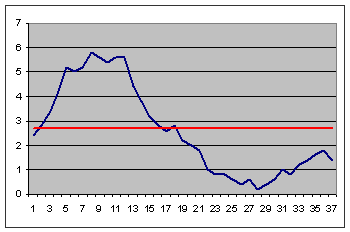
The chart shows FFA’s prediction of about 10 sec before then the ball drops. It is a relationship in between systems prediction and hits to the rotor. 80% of spins hit rotor within 18 pockets from prediction or 50% within nine pockets. This test matches theoretical explanation where final result will be about half of what scatter law let us have.
Here we have three graphs.
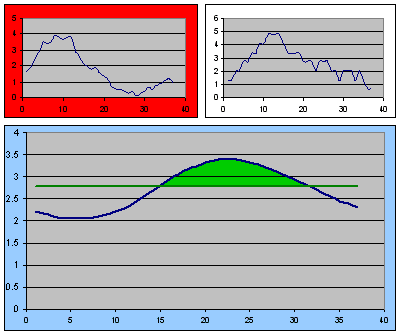 The red one is same as the one above (hits, prediction to the rotor). The white chart is a scatter or average ball jump on the roulette wheel (a typical example). On the red graph, the ball is hitting rotor about ten pockets from prediction. From the white chart, we can see that the ball most likely jumps 12 pockets.
The red one is same as the one above (hits, prediction to the rotor). The white chart is a scatter or average ball jump on the roulette wheel (a typical example). On the red graph, the ball is hitting rotor about ten pockets from prediction. From the white chart, we can see that the ball most likely jumps 12 pockets.
Blue graph shows final results where if we set the FFA to offset of 22 pockets we would have advantage marked with green area, and it averages to about 20%.
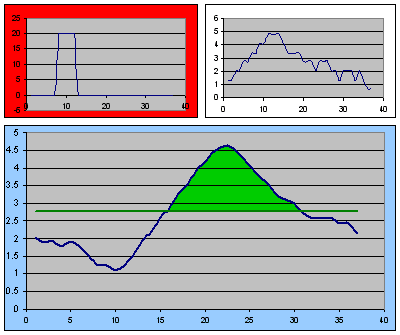 This picture is only an example for better understanding.
This picture is only an example for better understanding.
What if the FFA predicts hits to the rotor within five pockets accuracy?
Of course, we get a better result but not as much as we may expect since advantage can go only as far as the ball scatter let us have. Therefore even a perfect system and perfect wheel cannot produce complete results.
If roulette computer such as FFA is applied to wheel with a dominant drop point, prediction to rotor would be more accurate.
I didn’t have time to do a lot of testing but in most tests on such wheel huge percentage of spins end up within 5 pockets of accuracy. Such powerful prediction on some wheels can produce amazing returns. On this graph if this particular scatter is applied, if we play 7 pockets it would produce advantage of about 80%. It is huge advantage and if we talk about money it means that if we play $100 per number and cover 7 numbers in average after 100 spin we should end up with $56,000 profit. Alternatively if we play $10 per number it would be $5,600. If same is applied with 20% advantage it would be $14,000 and $1,400. In reality on wheels with dominant drop point if compared to same wheel with random drop point scatter may look different. In usual it may be worst for us because the ball would hit dominant diamond and rotor with wider angles and different forces which may cause various ball behaviors and ball jumps across rotor pockets.
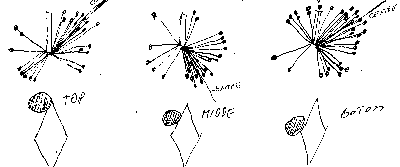
Here we have displayed what happens when the ball hits different diamond positions on the tilted wheel. I call it a plain prediction. If we add all three scenarios together even if we have very accurate prediction we do not get much of advantage since the ball scatter too wide.
The FF TILT2 system uses same error correction for ball timings as IQE6; therefore it has very accurate data about ball parameters which are used to shift prediction according to most expected ball jumps to achieve the best results. 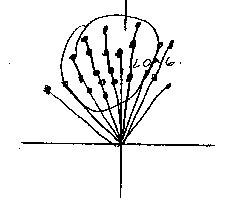
Such correction improves outcomes; however, it isn’t possible to develop it 100%.
Tilted or levelled roulette wheel
Tilted wheel (wheel with the ball-dominant drop point) is more comfortable to play.
With some conditions, it can produce and better advantage.
Main reasons for that is that on tilted wheel we can have more accurate predictions to the point where the ball will hit rotor. This combined with good conditions of reasonable scatter can produce huge advantage. Higher accuracy of prediction also helps player to easier define where the advantage is. It is important to say that prediction on tilted wheel is more constant since small changes (within limits) wouldn’t affect final result as it would happen on leveled wheel. Because of such changes on a leveled roulette wheel it is pointless just to observe prediction and final result and build graphs based on that. Such graph consists of 60% random results (the ball scatter), plus some percentage of inaccuracy in prediction. Therefore until we get enough spins to define where the advantage is, only a small change may cause that that graph is not valid any more. Playing roulette requires very dynamic player response especially if the game is on a leveled wheel.
On the other side with tilted wheel prediction at some particular points with ball timing, a small change in measured ball time as only 10ms may cause the ball to go for additional full rotation which creates error by the number of pockets related to how much the rotor would shift for that period. Or perhaps it may cause the ball to drop at the different then dominant drop point. On the levelled wheel, such scenario would cause an error of only three pockets. The FFA’s TILT2-R2 system is specially programmed where with proper setting in most cases it can avoid such situations.
Reasonably levelled roulette wheels are everywhere, and we can have 100% predictable spins while for example on the tilted wheel with a dominant diamond hit of 60% about 30% of spins may be avoided because the ball is not going to hit where it is expected. Also dominant diamond in one ball direction may not be dominant if the ball is going in opposite ball direction. Only the latest revision R2 of TILT2 system has especial adjustments for that where the system can be independently tuned for each ball direction separately.
I hope this article helps average reader to understand what the computerised roulette prediction is. There is so much to observe and to learn, and it is not easy at all, even if such accurate device as FFA is used.
If it is easy as some are claiming; a long time ago casinos would be out of business.
Whatever you do, do not forget that Big Brother is watching you all the time.
Reference material and some hard talk
As a reference material from which red graph is created, I used 100 spins from Stefano that comes with his mobile phone roulette computer. Since he is claiming it is a semi-tilted roulette wheel my curiosity was to find out how the FFA and the IQE6-R2 system would perform against that wheel.
Well, results of my test are as displayed on the graph.
However, I took some time to look results Stefano was getting with his mobile phone and Java program.
The phone predicts the outcome of the spin precisely, (he says) and the funny thing is in that the phone couldn’t predict the drop point with the better than the random result.
While Stefano has consistent final result his, predicted number and position where the ball hits rotor are not related at all. It is a clear example that mobile phone can’t accurately predict. Such results can be only a coincidence or manipulation.
It is much easier to edit video than to make working computer programmed in Java on inappropriate hardware. At that time Stefano did not know that expert eye looks for everything, but that doesn’t bother him since someone who doesn’t understand much may be impressed.
After few people highlighted this issue and spread the word, Stefano finally replaced all his videos, this time taking better care. I did not analyse his latest video, but from a quick look, it did look reasonable. Except that now he uses ~10 ball clicks for each spin and last year he was claiming how bad it is because my system uses few clicks.
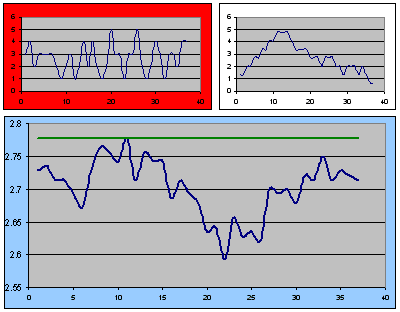
Graphs on the right are showing how Stefano’s prediction relates to drop point on the rotor.
These three graphs are what Steve Hourmouzes gets on his video at his own time with his roulette computer.
No, I am not joking, the red graph is his prediction versus ball drops on the rotor. It is clear that it is nothing more than a random result. Even if the ball doesn’t jump at all, he wouldn’t have any advantage since there are too many small pick points which of course will change all the time since prediction can never have only a single number advantage.
The white graph is same scatter diagram as I was using in previous examples.
Blue graph is a combination of top 2 charts. The green line represents the number of hits per 100 spins that we would need to have an advantage. Stefano’s all results based on his computer capability to predict failing point is under the line deviating around 2.7 which is roulette probability where from 100 spins we expect 2.7 hits (100/37=2.7). It is evident that his computer did not change house advantage at all. Please note that result deviates only ~0.15. Therefore, scale on the right-hand side of the graph is enlarged while on the next chart it is in 0.5’s.
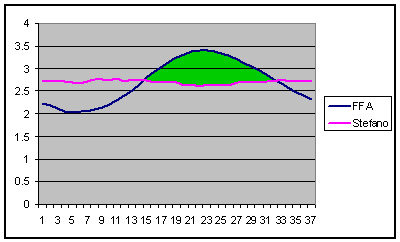
And finally, this is FFA compared with Stefano’s results.
While mobile phone prediction is deviating from negative 2.7, the FFA creates solid pick point (marked with green colour).
If you are interested, I do not mind to send you his spins on DVD but since it is his copyright you would need to ask him for permission which I believe you will not get since it is quite embarrassing for Stefano.
Even more embarrassing is his last statement when he tried to build a similar device as the FFA is.
Stefano claims, mobile phones aren’t so good in timing, but microprocessors have a problem in performing calculations. Does it make sense to you? It looks as he doesn’t understand that mobile phone uses a microprocessor as well but someone much smarter than him, who can program firmware and who knows Booleans algebra already programmed it to do what mobile phone should do. Every computer uses a microprocessor. The problem with mobile phones and Java program is that the program is done on top of firmware, operating system, interpreter and Java.
Therefore control of microprocessor registers and timers is imposable, and it is impossible to get accurate timing we need. (Just Google for Java timing problems) It is his problem that he doesn’t know how to program firmware to perform calculations required so the computer can do what it spouse to do.
The microprocessor will do whatever we program it to do. To use a mobile phones microprocessor to perform well all mobile phone software needs to be removed, and microprocessor should be programmed with machine language.
It is a bizarre claim (microprocessors can’t calculate) especially after he claims that he developed more powerful microprocessor then any other available on the market for his hybrid roulette computer.
This guy has no idea how many millions developing such processor would cost and on which scale it has to be manufactured to be cost-effective. Anyway, why would he use such processor if he can’t develop firmware for much smaller processor inside a mobile phone? Instead, he has to program in Java on top of already programmed mobile phone operating system. If Stefano used a small hand held computer it would be better, at least it wouldn’t be interrupted all the time while sending and receiving signals from communication tower as a mobile phone does.
Selling gambling systems
It may be very profitable therefore it is understandable why someone like Stefano Hourmozes created an extensive network of web pages with different domain names to attract uninformed people. Recently he did update all pages so it looks as he will continue doing it until there are people to buy it.
If you do some research on the internet, you will notice that only Laurence Scott and myself are not providing any money back guarantee with the system while the others are promising everything until someone buys it.
The irony in all of that is that only Laurance’s visual prediction and my system can produce an advantage.
I can speak only in my name, but since I study Laurance work, I may guess that his reasons for not providing guarantee are same as mine. The reason for that is that we want people to understand what really roulette prediction is and how advantage is created. My objective is not to attract and to sell to people without full understanding. Since I exactly know what my system can do there is no single person until now who purchased it and claimed differently.
What is the point of Stefano’s advertisement of 200% money back return if he doesn’t deliver it?
None of the people who I know could get their money back from him or anybody else who sells systems.
The only one person who managed to do it is Tony from France. Of course, he didn’t get 200% but his money. The reason that he managed to get it is that he spends most of his time on public forums and Tony made a threat to Stefano that he doesn’t care about his contract where he has to sign that he will not speak about the computer. Instead, he will write to all forums with hard proof that his computer is rubbish. At the same time, I was making pressure on Stefano to get a refund for some people from overseas. He tried to prove that my claims are false because I am “competitor” but he couldn’t fight two fronts, so he decided to shut up Tony and to refund his money.
Additional facts about Stefano roulette computer and his Genuine Winner system are at our Forum.
Since Tony (Bago) for few months was promoting Stefano’s roulette computer, arguing with me that it is something special it show us how much people without knowledge can be manipulated. For someone who understands it is enough to see Stefano’s video to know that computer is nothing more than a Java game simulating roulette prediction.
Mark Howe’s roulette video did look better, but since it was made from few parts, it is hard to tell if it is assembled from few lucky strikes. Also, it was created later then Stefano’s video. Therefore, Mark was aware that he needs to demonstrate and drop point related to prediction. The last person who bought Mark’s roulette computer (mobile phone) did not receive it. He lost his money. I did not hear from Mark for a long time, but he created two additional web pages where he is trying to sell his computer under a different name.
If buying system I strongly suggest not to use Western Union to wire the money to someone you do not know.
Instead, use a credit card via Paypal or Moneybookers. If you pay with credit card and if you get screwed you can claim money back, of course, if you do it fast enough.

Recent Comments